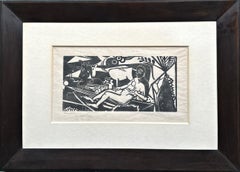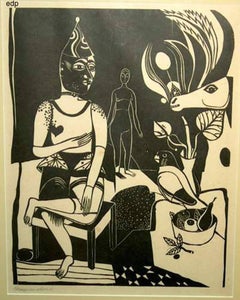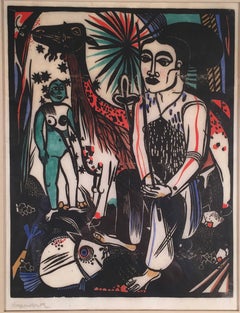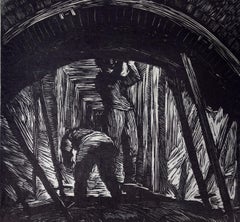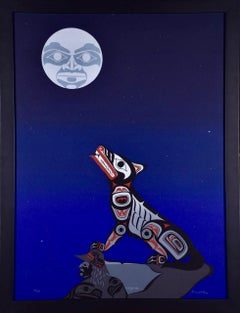Heinrich Campendonk Art
to
2
1
Overall Width
to
Overall Height
to
3
1
1
2
2
1
3
2
2
1
1
1
1
1
3
4
10,083
2,775
1,380
1,375
1
2
1
Artist: Heinrich Campendonk
Liegender Weiblicher Akt Mit Kuh Und Ziege Expressionist Woodcut
By Heinrich Campendonk
Located in Eltville am Rhein, DE
Heinrich Campendonk
Krefeld 1889 - 1957 Amsterdam
Reclining female nude with cow and goat, 1918
Woodcut on Japanese paper
Signed and dedicated in pencil lower left "for Lasar Segall ...
Category
1910s Blue Rider Heinrich Campendonk Art
Materials
Woodcut
SITZENDER HARLEKIN
By Heinrich Campendonk
Located in Portland, ME
Campendonk, Heinrich. SITZENDER HARLEKIN. Engels/Sohn 59. Woodcut, 1922. 15 x 11 3/8 inches; 380 x 290 mm. Signed in pencil. In Excellent condition. Framed.
Category
20th Century Expressionist Heinrich Campendonk Art
Materials
Woodcut
DER HIRT MIT DER GROSSEN ZIEGE (THE SHEPHERD WITH THE LARGE GOAT)
By Heinrich Campendonk
Located in Portland, ME
Campendonk, Heinrich. DER HIRT MIT DER GROSSEN ZIEGE (THE SHEPHERD WITH THE LARGE GOAT). WV47(b). Woodcut printed in colors, 1920. 12 5/8 x 9 7/8 inches; 321 x 250 mm. Signed in penc...
Category
1920s Heinrich Campendonk Art
Materials
Woodcut
Related Items
"Mine Shaft", Soviet Union: An Early 20th C. Woodcut Engraving by Abramovitz
By Albert Abramovitz
Located in Alamo, CA
This is a signed woodcut engraving entitled "Mine Shaft" created by Albert Abramovitz in 1935, after a trip to the Soviet Union. It depicts two Russian workers constructing a mine sh...
Category
1930s Heinrich Campendonk Art
Materials
Woodcut
$940 Sale Price
20% Off
H 13.38 in W 8.88 in
Midnight Wolf: A Limited Edition Clarence Mills Signed Haida Inuit Print
Located in Alamo, CA
"Midnight Wolf" is a framed signed limited edition abstract inuit native people's work by Northwest Coast Haida artist Clarence Mills. The print depicts a st...
Category
Late 20th Century Abstract Heinrich Campendonk Art
Materials
Woodcut
$860 Sale Price
20% Off
H 26.88 in W 20.63 in D 0.88 in
Modern American Industrial Landscape
Located in Buffalo, NY
An original woodblock print dated 1965, titled "Our Town" but signed illegibly.
Category
1960s American Modern Heinrich Campendonk Art
Materials
Paper, Woodcut
Zwei Frauen (Two Women) /// German Expressionism Karl Schmidt-Rottluff Woodcut
By Karl Schmidt-Rottluff
Located in Saint Augustine, FL
Artist: Karl Schmidt-Rottluff (German, 1884-1976)
Title: "Zwei Frauen (Two Women)"
Portfolio: Das Spiel Christa vom Schmerz der Schönheit des Weibes (The Play Christa from the Pain of the Beauty of the Woman)
*Issued unsigned
Year: 1918
Medium: Original Woodcut Engraving on wove paper
Limited edition: Unknown
Printer: Fritz Voigt, Berlin, Germany
Publisher: Verlag Die Aktion, Berlin, Germany
Reference: Schapire No. 222, page 45; Jentsch No. 35. Rifkind No. 2563; Lang No. 300; Reed No. 118
Overall size with attached page: 8.5" x 10.63"
Sheet size: 8.5" x 5.38"
Image size: 6.5" x 3.63"
Condition: Toning to sheet (as normal). A few tiny pinholes in right margin. In very good condition
Very rare
Notes:
Provenance: private collection - Oxnard, CA. Comes from a complete originally bound 48 page folio with 9 original woodcut engravings by Schmidt-Rottluff. Text by Alfred Brust. Presently attached to its accompanying page. The cover and title pages in pictures are not included, only for reference/provenance. There is an example of this work in the permanent collection of the Brücke Museum, Berlin, Germany.
Biography:
Karl Schmidt-Rottluff (born December 1, 1884, Rottluff, near Chemnitz, Germany—died August 9, 1976, West Berlin [now Berlin]), German painter and printmaker who was noted for his Expressionist landscapes and nudes.
In 1905 Schmidt-Rottluff began to study architecture in Dresden, Germany, where he and his friend Erich Heckel met Ernst Ludwig Kirchner and Fritz Bleyl...
Category
1910s Expressionist Heinrich Campendonk Art
Materials
Engraving, Woodcut
Latin American Judaica Conceptual Chassidic Art Modern Woodcut Luis Camnitzer
By Luis Camnitzer
Located in Surfside, FL
Luis Camnitzer and Martin Buber (1878-1965),
New York: JMB Publishers Ltd, 1970.
Printed at The New York Graphic Workshop.
Hand signed on Arches paper. (Edition 24/100, numbered on Justification page)
Woodblock prints based on folktales from the Hasidic Jewish tradition in Eastern Europe, selected by Camnitzer from the early masters section of Buber’s Die chassidischen Bücher as translated by Olga Marx. German Expressionist style Jewish woodcuts...
Category
1970s Expressionist Heinrich Campendonk Art
Materials
Woodcut
$1,100
H 25.5 in W 20.5 in
"Woman Desired by Man" original woodcut
By Max Pechstein
Located in Henderson, NV
Medium: original woodcut. Printed in 1920 for the Deutsche Graphiker der Gegenwart portfolio, and published in Leipzig by Klinkhardt & Biermann in an edition of 500. Catalogue refere...
Category
1920s Expressionist Heinrich Campendonk Art
Materials
Woodcut
"Daikoku, Dieu de la Richesse" Japanese Style Woodblock Print
By Paul Jacoulet
Located in Austin, TX
A woodblock print of a Japanese geisha in elegant clothing against a yellow decorative background.
By Paul Jacoulet
15.5" x 12" Woodblock print on paper
Framed Size: 22.5" x 18.5"
...
Category
Mid-20th Century Heinrich Campendonk Art
Materials
Paper, Woodcut
$2,500
H 15.5 in W 12 in
"Self Portrait" original woodcut
By Conrad Felixmuller
Located in Henderson, NV
Medium: original woodcut. Printed in 1920 for the Deutsche Graphiker der Gegenwart portfolio, and published in Leipzig by Klinkhardt & Biermann in an edition of 500. Catalogue refere...
Category
1910s Expressionist Heinrich Campendonk Art
Materials
Woodcut
"Männlicher Kopf" original woodcut
By Karl Schmidt-Rottluff
Located in Henderson, NV
Medium: original woodcut. Printed in Germany in 1917 for Die Aktion; this impression is from the deluxe edition of 100 on Bütten laid paper. Catalogue reference: Schapire 202. Image ...
Category
1910s Expressionist Heinrich Campendonk Art
Materials
Woodcut
Horses - XX century, Woodcut print, Black and white, Figurative-abstract
By Ludwik Maciąg
Located in Warsaw, PL
LUDWIK MACIĄG (b. 1920- d.2007) Studied at the Faculty of Painting at the Academies of Fine Arts in Cracow and Warsaw. He graduated in 1951. He was a professor and a dean of the Facu...
Category
Late 20th Century Other Art Style Heinrich Campendonk Art
Materials
Paper, Woodcut
"Skating on Ladies' Pond Central Park": Winslow Homer 19th C. Woodcut Engraving
By Winslow Homer
Located in Alamo, CA
This Winslow Homer woodcut engraving entitled "Skating on the Ladies' Skating-Pond in Central Park, New York", was published in Harper's Weekly in the January 28, 1860 edition. It depicts a large number of men, women and children skating on a recently opened pond in Central Park. At the time of publication of this engraving, Central Park was in the early stages of construction. This engraving documents the very early appearance of Frederick Law Olmstead and Calvert Vaux's masterpiece of landscape design. According to Olmsted, the park was "of great importance as the first real Park made in this century – a democratic development of the highest significance". The people of New York were very proud of the plans for their park. It was stated at the time: "Our Park, which is progressing very satisfactorily under the management of the Commissioners, will undoubtedly be, one of these days, one of the finest place of the kind in the world...Those who saw the Park before the engineers went to work on it are amazed at the beautiful sites which have been contrived with such unpromising materials; all fair persons believe that the enterprise is managed with honesty and good taste."
Skating was rapidly rising in national popularity in part due to the opening of Central Park’s lake to skaters on a Sunday in December 1858 with 300 participants. The following Sunday it attracted ten thousand skaters. By Christmas Day, a reported 50,000 people came to the park, most of them to skate. There were rules governing who could use the skating pond. “The Ladies’ Pond...
Category
1870s American Impressionist Heinrich Campendonk Art
Materials
Engraving, Woodcut
$940 Sale Price
20% Off
H 23.13 in W 29.5 in D 1.13 in
Männlicher Kopf an weibliche (Male Head Leaning against Female) /// Rottluff
By Karl Schmidt-Rottluff
Located in Saint Augustine, FL
Artist: Karl Schmidt-Rottluff (German, 1884-1976)
Title: "Männlicher Kopf an weibliche (Male Head Leaning against Female)"
Portfolio: Das Spiel Christa vom Schmerz der Schönheit des Weibes (The Play Christa from the Pain of the Beauty of the Woman)
*Issued unsigned
Year: 1918
Medium: Original Woodcut Engraving on wove paper
Limited edition: Unknown
Printer: Fritz Voigt, Berlin, Germany
Publisher: Verlag Die Aktion, Berlin, Germany
Reference: Schapire No. 225, page 46; Jentsch No. 35. Rifkind No. 2563; Lang No. 300; Reed No. 118
Sheet size: 8.5" x 5.38"
Image size: 6.25" x 3.57"
Condition: Toning to sheet (as normal). In very good condition
Very rare
Notes:
Provenance: private collection - Oxnard, CA. Comes from a complete originally bound 48 page folio with 9 original woodcut engravings by Schmidt-Rottluff. Text by Alfred Brust. The cover and title pages in pictures are not included, only for reference/provenance. There is an example of this work in the permanent collection of the Brücke Museum, Berlin, Germany.
Biography:
Karl Schmidt-Rottluff (born December 1, 1884, Rottluff, near Chemnitz, Germany—died...
Category
1910s Expressionist Heinrich Campendonk Art
Materials
Engraving, Woodcut
Heinrich Campendonk art for sale on 1stDibs.
Find a wide variety of authentic Heinrich Campendonk art available for sale on 1stDibs. You can also browse by medium to find art by Heinrich Campendonk in woodcut print, paper, vellum and more. Much of the original work by this artist or collective was created during the 20th century and is mostly associated with the Expressionist style. Not every interior allows for large Heinrich Campendonk art, so small editions measuring 10 inches across are available. Customers who are interested in this artist might also find the work of Otto Mueller, Max Pechstein, and Alfred Kubin. Heinrich Campendonk art prices can differ depending upon medium, time period and other attributes. On 1stDibs, the price for these items starts at $300 and tops out at $35,000, while the average work can sell for $3,750.
